
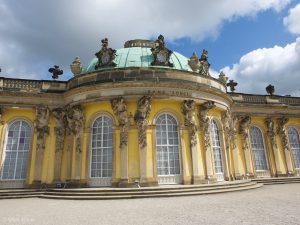
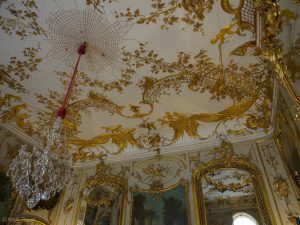

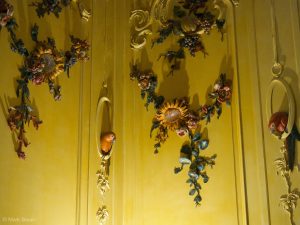
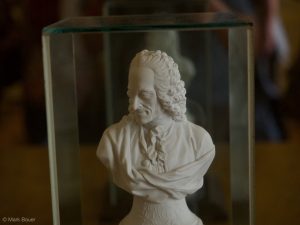


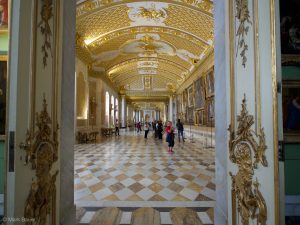

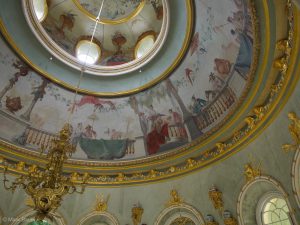

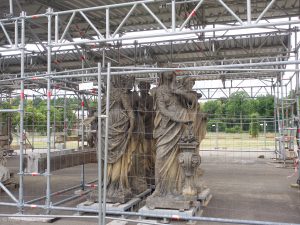

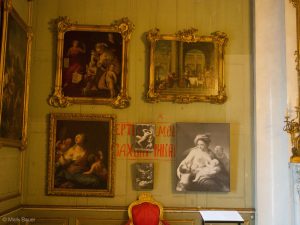
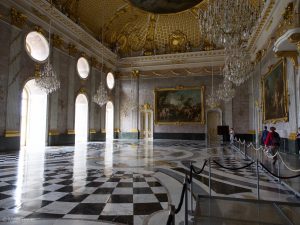
We got up fairly early and had a good hotel breakfast—not as wonderful as before, but certainly big—this hotel is for hundreds of guests and the breakfast room is huge. They also had scrambled egg and sausages, but those weren’t that great. The most novel item was that they had little edible cups for the jams and honey (made out of the stuff from which sugar cones are made). Then we took off for Potsdam, way outside of Berlin, because I had never been here before and wanted to see some of the gardens and palaces. So we took the train out of town about 40 minutes, then a bus for another 20, and bought tickets that would let us see all the buildings that are part of Potsdam‘s palaces. We started with Sanssouci, then wandered through the humongous park and formal gardens, stopping at various other buildings, and eventually also toured the New Palais at the other end of the park.
The Kings of Prussia started to live here in the 18th century, and Frederick the Great in particular was responsible for the major palaces, his „retreat,“ Sanssouci (French for „No worries“) and the New Palais, which was the more pompous and representative building that was needed as Prussia became more important. Even though he was king during the 18th-century enlightenment and endorsement rational thinking and „enlightened absolutism“ (and at times big buddies with Voltaire, until Voltaire had had enough of him), his taste in the arts was solidly 30 years out of date, and he ordered everything to be done in rococo style—completely overblown and overdecorated in gold, silver, shells, and elaborate wood carvings. Of course I learned about the rococo in my art history class, but this was over the top even for rococo and, because it is so far behind its time, is actually known as “Frederician rococo” for Frederick the Great’s preferred style. Examples for over-the-top-ness were a room with dozens of almost identical paintings all by Watteau, the prime French rococo painter of his time, as well as a room with gilded ceiling and wall decor that included a golden spider’s web, and a room covered in colorful 3-D wood carvings that included not just flowers and leaves but also parrots and a monkey, all bending down from the walls. This was all just in Sanssouci, where Frederick received special friends and entertained his favorite intellectuals with French conversation (his German was terrible) and with music. He played the flute even during military campaigns and brought his flute teacher along (that’s the kind of stuff you learn from Audioguides).
But beyond Sanssouci, we were in the Sanssouci kitchen (which was not added until the 19th century and had a very practical-looking cast-iron stove of enormous proportions) and in the picture gallery. This was a beautiful marble hall, but had too many pictures in it, mostly Frederick’s “rejects,” the Dutch paintings by Rubens that he didn’t particularly like, and a Caravaggio, but otherwise mostly minor painters and simply too many of them. Among the many, many scenes from Greek mythology with naked men and women, we did discover an especially risqué one, “Sacrifice to Priapus,” which provided a bit more entertainment. We then took a little break from the ornamental excesses and went to look at the reconstructed windmill right by the palace, which was not only tourable but also actually running. That was fun to see. We then had sandwiches made with mill bread and a shared piece of raspberry cake for a light lunch, so we could keep going.
We also found our way through the park to the “China House,” which was another ridiculous rococo contraption featuring the fad of “Chinoiserie” or Chinese-style decor, including vases and Chinese-style wall ornamentation, but in this case also gilded statues that were a wild orientalist mix of Chinese straw hats and umbrellas, turbans and veils, and even (we thought) some Native American feather headgear.
By this time, we were getting a little tired of the rococo, but we did walk through the rest of the park to the New Palais and did the tour there as well. That was probably overkill—I was definitely getting very tired of the gold, silver, and silk excesses in the many, many rooms there. (As Mark pointed out, it looked like a glitter bomb had gone off in every room—rather painful given that my taste in room decor is basically Bauhaus/ Frank Lloyd Wright plus Ikea!) But the main “state rooms” for entertainment/pomp and circumstance were interesting—downstairs, a huge room decorated with shells and mollusks all over, unique for an indoor space rather than an outdoor grotto, and because rulers after Frederick decided it wasn’t crazy enough and added colorful pieces from their mineral collection to the decor. And upstairs, directly above it, an equally huge room with a very beautiful marble floor that has always had structural problems because even though it is 70 meters (70 yards!) long, it has no supporting columns because Frederick insisted that would mess with his grotto. Apparently, only the restoration a few years ago finally fixed the issue after many, many repairs.
The restoration of the Palais is actually an ongoing process—we could only look at some of the rooms and there was visible damage in a number of spots on the walls and ceilings. There was also a spot where the Cyrillic writing of Russian soldiers who lived in the palace after WWII was left visible behind the paintings. And an exhibit that covered several of the rooms documented the exit of the emperor and his family from the castle in 1918, since this is the 100th anniversary of the end of the German Empire. The Palais was pretty much not kept up for many years after WWI and then especially WWII, and the current restoration is a never ending process. We saw tons of statues (literally) that are currently “in prison” as they are being restored—a strange sight, but there are hundreds all over the exterior of the building, and many in bad shape from environmental damage.
After the New Palais, we were definitely done! We took the train back into town at about 4, and met up with Kai and Bruce, who had flown back from Greece today, at the McDonald’s at the main station (very classy). We retrieved Kai’s luggage from Bruce’s hotel room and then took the S-Bahn to Laurie’s in Charlottenburg. Kai had a pretty good memory for where it was, so we found the apartment complex quickly, re-met Mauro and Stella, Laurie’s kids, and then went to get Indian take-out for everyone around the block. It was delicious, but we really didn’t get enough vegetarian options—I felt bad because we thought about it the wrong way, but we did ok nonetheless. We stayed only a little while after dinner, because Bruce needed to get back to his hotel, and Mark and I were rather tired after a long day. We said goodbye to Bruce as we got out 3 stations before him, and were back at the hotel by 10, too tired to do our blog!